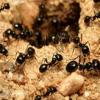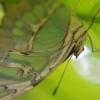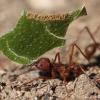If you would provide the common, scientific, and the cast of ant it would be greatly appreciated.
1. Location of collection: This ant was captured in central Florida, Tampa Area.
2. Date of collection: 11-18-17. However- it was obtained from an excavated nest.
3. Habitat of collection: In a sandy area under an oak tree.
4. Length: 4-5mm.
5. Coloration, hue, pattern and texture: This is a dark ant. The head has a red hue & the gaster has a striped pattern of black and a dark red.
6. Distinguishing characteristics: This ant was bigger than most workers but about the same length as the big-headed workers in the colony. It's Gaster was bigger than the others.
7. Anything else distinctive: Colony was polymorphic. There were small workers and workers (majors?) with big heads and large mandibles. The brood was not in a cocoon. You could see an white ant shape larva (I hope I'm using the terms correctly). I also observed some of these ants that had yet to develop be an orange color that I assume means they would soon be ready to awaken. The workers enjoyed a cap full of ground hemp seeds I fed them.
8. Nest description: Nest was small, not a large mound. It was in sandy soil.
9. Nuptial flight time and date: N/A Taken from excavated nest
Again, if you would provide the common, scientific, and the cast of ant it would be greatly appreciated.
Attached Files
Edited by Roku9710, November 18 2017 - 2:10 PM.
























